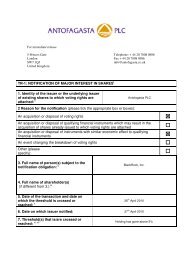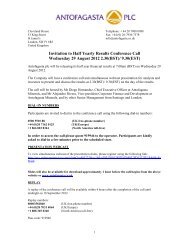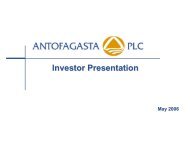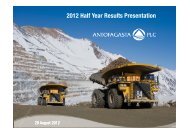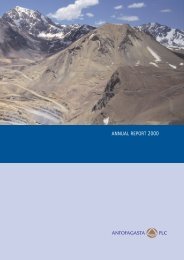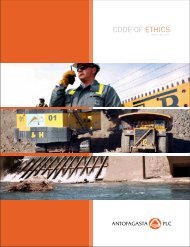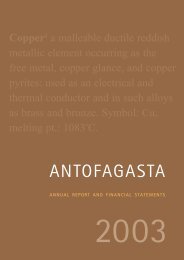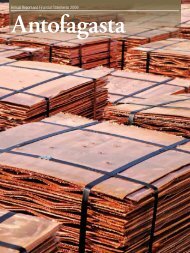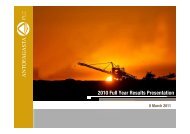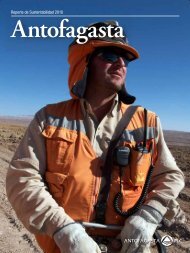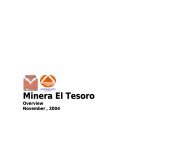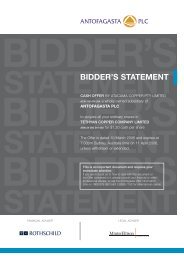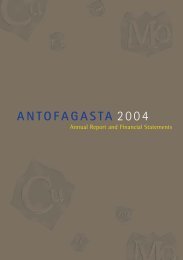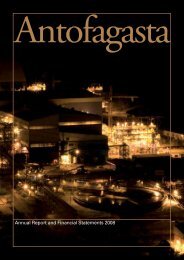Sustainability Report - Antofagasta PLC
Sustainability Report - Antofagasta PLC
Sustainability Report - Antofagasta PLC
You also want an ePaper? Increase the reach of your titles
YUMPU automatically turns print PDFs into web optimized ePapers that Google loves.
32<br />
<strong>Antofagasta</strong> plc <strong>Sustainability</strong> <strong>Report</strong> 2011<br />
<strong>Sustainability</strong> strategy, governance and management<br />
Management systems and auditing<br />
<strong>Antofagasta</strong> Minerals has management systems, including key<br />
performance indicators, for monitoring progress on social and<br />
environmental performance across the mining companies:<br />
The Assessment of Environmental Performance (AEP) tool, was<br />
introduced in 2010 and is structured around three dimensions: efficiency<br />
in the use of resources (water, fuel, energy); controlling environmental<br />
impacts (climate change, water quality, biodiversity, waste and air quality);<br />
and benefiting the environment (biodiversity conservation, enhancement<br />
of cultural heritage and support for alternative energy sources). Each<br />
mining company sets environmental goals that reflect local priorities.<br />
See page 48.<br />
In 2011 <strong>Antofagasta</strong> Minerals developed detailed standards for the<br />
aspects of environmental performance covered in the AEP tool. A set of<br />
‘Environmental Management Best Practice’ handbooks help operational<br />
managers apply the standards to the specific challenges at their site. The<br />
handbooks cover the life-cycle of the mining process, from exploration to<br />
mine closure, and are aligned with international guidance, for instance,<br />
from the International Council on Mining and Metals (ICMM).<br />
The Assessment of Social Performance (ASP) tool, was designed and<br />
validated throughout 2011 and will be implemented in all operations in<br />
2012. The main issues covered are health and safety, labour relations,<br />
opportunities for employee development, stakeholder relationships and<br />
community investment.<br />
See page 44.<br />
By the end of 2012 we aim to gather baseline data for each of the social<br />
key performance indicators. This will enable each mining company to set<br />
goals for performance from 2013 and track progress towards them.<br />
<strong>Sustainability</strong> key performance indicators and goals are included in the<br />
performance agreements between each mining company and <strong>Antofagasta</strong><br />
Minerals. These are tracked through the monthly operational performance<br />
reviews and through reports submitted by the mining companies to the<br />
Board.<br />
Regular internal operational audits monitor compliance across the mining<br />
companies. External auditors assess contractor compliance with safety,<br />
human rights and labour standards, including criteria on fair wages,<br />
collective bargaining, paid overtime, holidays, and standards prohibiting<br />
child labour and forced labour.<br />
Integrating sustainability<br />
Achieving its sustainability goals requires the support and expertise of all<br />
<strong>Antofagasta</strong> Minerals’ employees and contractors. Each mining company’s<br />
sustainability goals are embedded within its annual performance<br />
agreements with <strong>Antofagasta</strong> Minerals. They are reflected in employment<br />
contracts and remuneration and in agreements with contractor companies.<br />
<strong>Antofagasta</strong> Minerals works to embed a culture of responsible<br />
environmental stewardship. For example, it publishes regular newsletters to<br />
share environmental news and tips to help employees reduce their impact<br />
on natural resources and behave responsibly.<br />
Exploration: Social and environmental criteria are integrated into the early<br />
stages of the mining cycle, including exploration and project development,<br />
and form part of our due diligence processes. During the explorations stage,<br />
our ‘Social & Environmental Best Practices Manual for Exploration’ is used<br />
during planning and field work. Our External Affairs and Environmental<br />
Advisors work closely with the Exploration Health, Safety, Environment and<br />
Quality officer, responsible for overseeing management of sustainabilityrelated<br />
risks at exploration sites. This helps to ensure that workers and<br />
contractors abide by minimum standards when dealing with local<br />
communities or the surrounding environment.<br />
Social and environmental due diligence processes are also carried out<br />
during early investment phases to identify socio-political, operational, safety,<br />
environmental and reputational risks.<br />
Project evaluation & construction: The design of new mining projects<br />
must follow our ‘Asset Delivery System’ developed in 2011, which lays down<br />
a set of minimum standards, including social and environmental standards,<br />
to be considered from the scoping study through to the pre-feasibility,<br />
feasibility and construction phases.<br />
Operation: All operations regularly report on their environmental and social<br />
performance, measured through key performance indicators.<br />
Closure: <strong>Antofagasta</strong> Minerals aims to close and decommission its facilities<br />
in a way that is environmentally safe. We have updated closure plans and<br />
provisions in place for all mining operations.<br />
For example, since 2008 Los Pelambres has developed its closure plan for<br />
an old tailings dam at Los Quillayes that ceased to operate when replaced<br />
by the El Mauro dam. This plan was designed with the active participation of<br />
the neighbouring Cuncumén community, taking into account agreed criteria<br />
on safety, the environment and job opportunities for local people.<br />
See case study, page 45.



